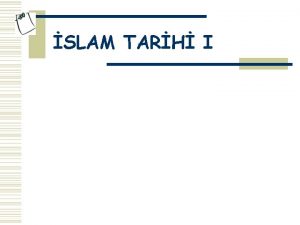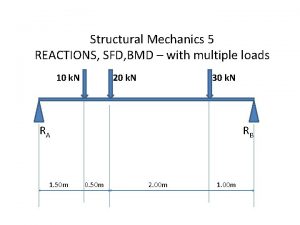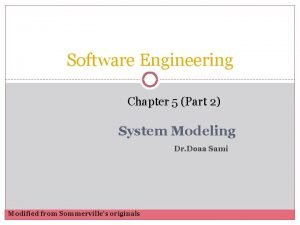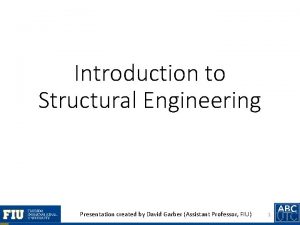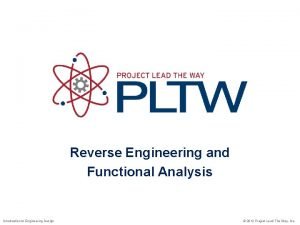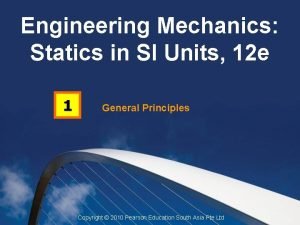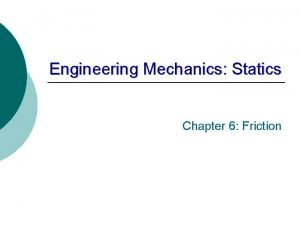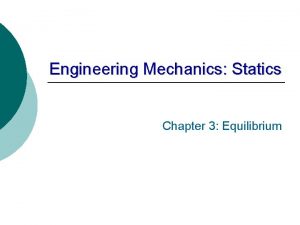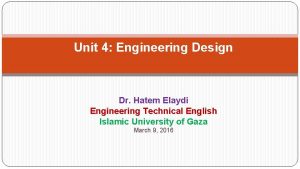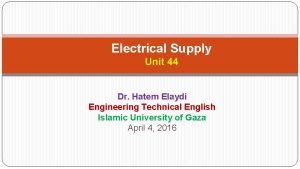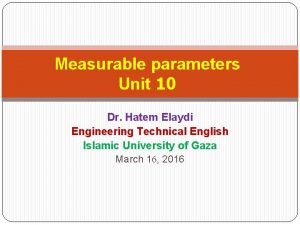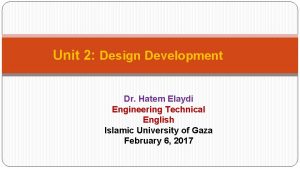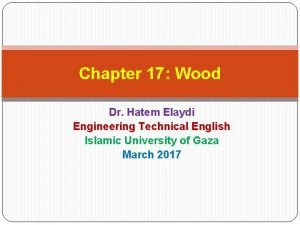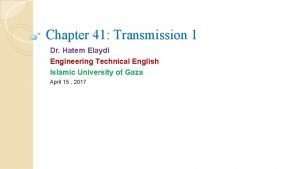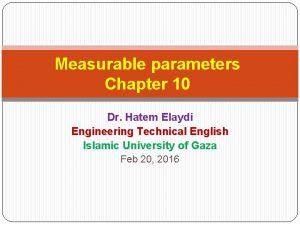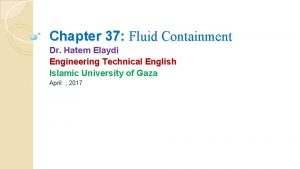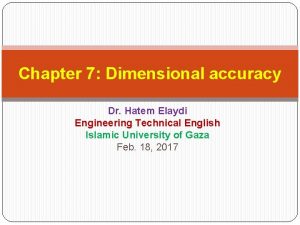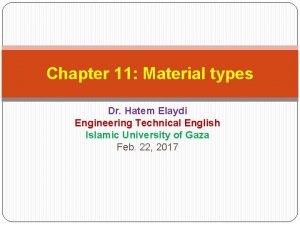Structural Mechanics Unit 32 Dr Hatem Elaydi Engineering











- Slides: 11

Structural Mechanics Unit 32 Dr. Hatem Elaydi Engineering Technical English Islamic University of Gaza March 26, 2016

Outlines A. Statically determinate structures B. Resultant forces and centre of gravity C. Frames and trusses Dr. Hatem Elaydi, IUG, Spring 2016, ENGG 1305 2

A. Statically determinate structures When a structural member- that is, part of a structure- is loaded in a certain direction, the load will cause a reaction. This means that another force, equal to the load, will act in the opposite direction. The reaction will counteract (resist) the load and stop the member from moving. When the loads and reactions acting on a member are equal, we say it is in equilibrium. Structures that are designed not to move - to stay in equilibrium- are called statically determinate structures. Dr. Hatem Elaydi, IUG, Spring 2016, ENGG 1305 3

B. Resultant forces and centre of gravity Often, a structural member will need to carry different loads of different magnitudes, acting in different directions. To calculate the result of these different component forces, an engineer can calculate a resultant force (or resultant). This is a force with a magnitude and direction equal to all the component forces together. One of the main forces exerted on a structure is gravity. This acts vertically downwards (see Unit 9). Gravity is exerted on every atom of an object. However, to simplify their calculations, engineers assume that gravity is exerted on one imaginary point called the centre of gravity. Depending on the shape of the object, this point may be inside the object's cross-sectional area, or outside it (see the diagrams below). Dr. Hatem Elaydi, IUG, Spring 2016, ENGG 1305 4

B. Resultant forces and centre of gravity Dr. Hatem Elaydi, IUG, Spring 2016, ENGG 1305 5

C. Frames and trusses A frame (or framework) is made from a number of relatively thin members. Examples are bicycle frames and steel-frame buildings. The members of a frame can form a complex shape- often with many triangles -called a lattice. The advantage of triangles is that they are stiff- they strongly resist deformation. Triangular assemblies can therefore be used to stiffen (or brace) structures. Dr. Hatem Elaydi, IUG, Spring 2016, ENGG 1305 6

C. Frames and trusses In diagram 2, the structure deforms because the joints between the thin members are weak and can flex easily. Joints which flex- because they are weak or because they are designed to do so -are called pin joints. Lattices which are entirely pin-jointed, and which therefore need cross members to stiffen them, are called trusses. A truss contains two types of member. Members that resist tension are called ties, and members that resist compression are called struts. A joint which does not flex is called a rigid joint (or moment connection). Rigid joints are often thick and securely joined- for example, by welds. Dr. Hatem Elaydi, IUG, Spring 2016, ENGG 1305 7

32. 1 Complete the explanation using words and expressions from A opposite. You will need to change the form of one word. In (1). . . . , each load acting on the structure is (2). . . . by a (3). . . . This means the structure always remains (4). . . . Dr. Hatem Elaydi, IUG, Spring 2016, ENGG 1305 8

32. 2 Complete the text using words and expressions from A, B and C opposite. Dr. Hatem Elaydi, IUG, Spring 2016, ENGG 1305 9

Strut: a rod or bar forming part of a framework and designed to resist compression 23. 3 In Diagram 2 below, which of the members (a-c) are ties, and which are struts? Dr. Hatem Elaydi, IUG, Spring 2016, ENGG 1305 10

32. 4 Choose the correct words from the brackets to complete the sentences. 1. Trusses are (frameworks / ties). 2. A connection between members which flexes is called a (pin joint / rigid joint). 3. Struts are designed to resist (compression / tension). 4. By adding cross-members, a frame is (braced / pin-jointed), making it stiffer. Dr. Hatem Elaydi, IUG, Spring 2016, ENGG 1305 11
 Kalbül ceyş
Kalbül ceyş Sfd and bmd
Sfd and bmd Mechanical technology automotive grade 11
Mechanical technology automotive grade 11 What is domain model in software engineering
What is domain model in software engineering Structural engineering presentation
Structural engineering presentation Eacademics iitd student login
Eacademics iitd student login Functional analysis examples engineering
Functional analysis examples engineering Function black box
Function black box Engineering mechanics statics in si units
Engineering mechanics statics in si units Cone of friction in engineering mechanics
Cone of friction in engineering mechanics Statics chapter 3
Statics chapter 3 Statics problems and solutions chapter 2
Statics problems and solutions chapter 2
